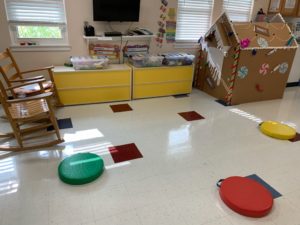![]()
In normal times, the start of the day at the child care program at Sarah’s House is a joyful and rambunctious scramble. Parents gather to sign in their children while kids rush into classrooms to greet friends and choose from shelves full of toys and books. During a pandemic, that scene looks very different.
When the child care program re-opened in mid-September, following nearly six months of closure because of the COVID-19 pandemic, families found a new set of regulations.
Parents signed up to drop off and pick up their children at specific times, ensuring they would not overlap with other families. Preschool children found their toys in plastic containers marked with their names to ensure they had individual crayons, Legos, and cot sheets for naps. And “circle time” was replaced by one-on-one learning and the kind of social distancing that will prevent the spread of the coronavirus.

In the preschool classrooms, shelves face the wall, and staff have created totes for each child’s supplies.
This is what it takes to run a child care setting in 2020, said Alexis Tucker, who directs the child care program at Sarah’s House, a supportive housing program run by Catholic Charities to offer emergency shelter and an array of other services for families experiencing homelessness in Anne Arundel County.
“You still hug the children,” she said. “Teachers just have to keep on their face covering.”
Re-thinking the approach
Immediately before COVID-19 hit Maryland, the child care program served 21 children between the ages of 6 weeks and 12 years, with the capacity to support as many as 40. All participants are part of families who are receiving support from Sarah’s House, whether they live on property or in off-campus residences.
The pandemic forced the child care facility to close for about six months. It re-opened in September with five children – one in the nursery, two in the toddler section, and two in the area serving school-aged children. For many, the traumas of homelessness have been compounded by the painful effects of COVID-19.
During the program’s closure, Tucker and her team spent time re-thinking their approach and developing an in-depth manual that not only considers how to deep clean the facility on a regular basis (with infant-friendly cleaners and bleach), but also re-imagines teachers’ roles when sharing toys, group learning, and cozy cuddles are not realistic options.
In the toddler area, for example, Tucker said, “We can’t have it too appealing.” She and her colleagues tucked children’s toys and belongings into individual totes, assigned each student a mat and a specially marked place in the classroom, and turned around the shelving to avoid showcasing toys or books that might draw the attention of tiny hands.

In the toddler classroom, mats mark a socially distanced space for each child.
In the preschool bathroom, the program established protocols that allow the end toilets to be used at the same time – and then cleaned while another child uses the middle toilet.
In the school-aged area, a donated hot-spot device has provided adequate Wi-Fi for children to attend virtual classes, with some technological support.
“The upside of this is that it has made us think of other ways to teach,” Tucker said, adding that the facility is providing much more one-on-one instruction. “The downside is that you’re operating with much less, but doing much more work.”
The child care program at Sarah’s House is typically funded through state-subsidized vouchers, which are now significantly reduced, along with the facility’s capacity.
Those interested in supporting the center could consider volunteering to tutor individual students remotely; or donating masks, sanitizers, nap-time dividers or individually packaged drinks or snacks. Please contact Tucker at atucker@cc-md.org to coordinate any support.
